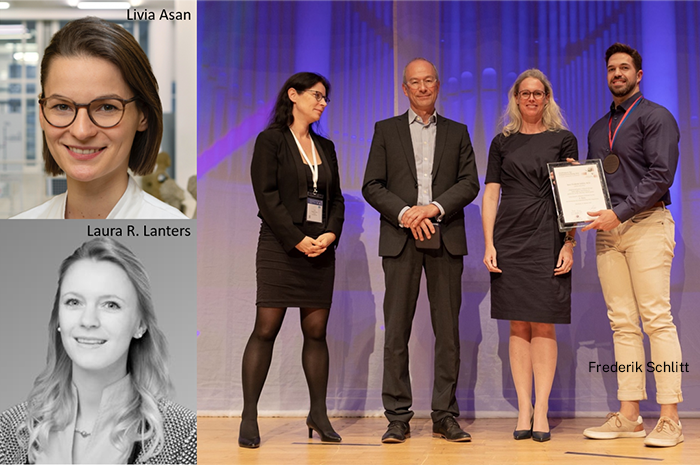Three early career researchers from the Department of Neurology at the University Medical Center Essen received awards for pain research. The three innovative projects focus on expectancy and learning mechanisms in the perception and processing of pain, both in healthy individuals and in patients. Congratulations to Frederik Schlitt* for the 2nd prize in the category Clinical Research on his work in pain-related learning mechanisms in patients with chronic back pain. Dr. Laura Ricarda Lanters** accepted the 2nd prize in the Basic Research category for her work on the specificity of conditioned nocebo effects in visceral interoceptive pain. The prizes were awarded by the German Pain Society and the donor Grünenthal GmbH. Livia Asan*** can be excited the 1st place of the Young Investigator Award for Pain. She wants to investigate how adverse effects after lumbar puncture can be avoided.
"We are very proud that this year scientists from the University Medical Center Essen were represented in every category of the highest award for pain research in Germany. Their work confirms the success of the interdisciplinary, cross-project collaboration in the Translational Pain Research Unit at the Center for Translational Neuro- and Behavioral Sciences," said Prof. Ulrike Bingel, head of the Center for University Pain Medicine and spokesperson of the SFB/TRR 289 Treatment Expectation.
*Frederik Schlitt, Department of Neurology, Center for Translational Neuro- and Behavioral Sciences (C-TNBS), University Medical Center Essen, received the 2nd prize in the Clinical Research category for his research on pain-related learning mechanisms in chronic back pain. Pain-related learning mechanisms seem to play a key role in the development and maintenance of chronic pain. Initial studies have been able to show impairments in pain-related learning in patients with chronic pain. However, the results are not consistent. Frederik Schlitt investigated pain-related learning and unlearning of visual cues that announced a painful heat stimulus or predicted its absence - in patients with nonspecific chronic back pain and healthy subjects. In patients with chronic back pain, reduced pain-related learning was observed both from cue stimuli that announced a heat pain stimulus and from those cue stimuli that predicted its absence. The data provide preliminary evidence for more diminished learning of cue stimuli that announce a heat pain stimulus with increasing clinical pain duration. Given the high prevalence of chronic low back pain in the general population, as well as the challenges that arise in its treatment, this work highlights the high clinical relevance of altered pain-related learning in this patient population. If the ability to discriminate between cues that announce a pain stimulus and cues that predict its absence is impaired, this may lead to ambiguity in the emotional appraisal of these stimuli and, subsequently, to overprotective behavior, which could contribute to the development and maintenance of chronic pain. The project was funded by the Collaborative Research Center 1280 "Extinction Learning".
**Dr. Laura Ricarda Lanters, Department of Neurology, Associate of the Translational Pain Research Unit led by Prof. Dr. Ulrike Bingel, demonstrated the relevance and specificity of visceral pain across methods in her work. In two consecutive but independently conducted fMRI studies, the team was able to show that interoceptive visceral stimuli are rated as more aversive compared to different exteroceptive stimuli by healthy subjects, even if both stimuli were perceived intraindividually as initially comparably unpleasant or painful. In both studies, cue stimuli announcing interoceptive visceral stimuli were found to be prioritized for learning, storage, and recall in healthy subjects compared with exteroceptive cue stimuli, accompanied by greater involvement of the insula and cingulate cortex for the visceral modality. The prioritization of learning processes with respect to negative expectation of clinically-relevant interoceptive compared to exteroceptive stimuli represents an addition to the understanding of conditioned nocebo effects for the development and maintenance of chronic pain and thus has high relevance for further research and, prospectively, therapy of functional and inflammatory diseases along the brain-gut axis. "In our understanding, the studies presented in the submitted work have a particular clinical validity due to the pain models used - e.g., rectal distensions for the visceral stimuli versus thermal stimuli on the skin- and thus, from a translational perspective, probably represent an interface between basic research conducted in healthy subjects and clinically oriented research with the aim of deepening the understanding of the underlying mechanisms of visceral pain along the brain-gut axis," explains Dr. Lanters. The work originated as a collaboration between two projects in the SFB 1280 "Extinction Learning" under the project leadership of Prof. Sigrid Elsenbruch (A10) and Prof. Harald Engler (A12) at the Institute of Medical Psychology and Behavioral Immunology in close collaboration with the Department of Neurology, Translational Pain Research Unit and the Institute of Diagnostic and Interventional Radiology and Neuroradiology, which are united under the umbrella of the C-TNBS.
*** Livia Asan, assistant physician and researcher at the Department of Neurology and C-TNBS, Unversitätsmedizin Essen, received the German Pain Society's Young Investigator Award for Pain (1st place). The award-winning project aims to investigate how adverse effects following lumbar puncture can be avoided. During lumbar puncture, a few milliliters of nerve fluid are extracted from the spinal canal and then analyzed. Nerve water analysis has a high value in neurological diagnostics for a wide range of diseases and is therefore performed in many of our patients. Although lumbar puncture is a very safe and low-risk procedure, patients sometimes complain of mostly harmless but nonetheless limiting side effects such as headache. There has been evidence in previous studies that the rate of post-puncture headache is significantly dependent on prior education in this regard. Ms. Asan would now like to test whether some of these complaints can be reduced by optimizing the positive design of the physician's risk information.

